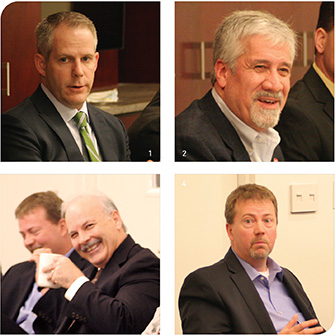
1. Paul Neidlein noted that many new technologies had yet to demonstrate true value. | 2. The ability to access documents in the field was a huge advance, said Vince Migliazzo. | 3. Owners chasing lowest-cost options, said Dan Rowe, can be working against their best interests. | 4. Steve Swanson touted the benefits of Building Information Modeling systems.
“I think sometimes the delivery method that the owner chooses isn’t conducive to their goals,” said Dan Rowe, president at Treanor Architects. He argued that owners may theoretically prefer integrated delivery, but they will often choose the lowest-cost option.
“There seems to be a little trepidation by some of the owners,” said Bowman. He agreed, though, that the more carefully integrated the design process was, the more successful the project would be. “I think the challenge in this room is to convince the owners of that,” said Bowman.
“We still hear a lot of ‘so what’ from the customer,” said Hancock. He noted that there was still a ”hard dollar mentality” in this economy. Because of its fragility, customers are less impressed by innovation than they might otherwise be.
“There needs to be a paradigm shift,” said Rezac. “The integrated process is a completely different way to look at [construction]. There are so many advantages to it, so it is very exciting. You just have to convince the owners and the clients out there that there is a value that comes out of that process.”
“The owners are going to start demanding some of this,” said Eric Bosch, the city architect for Kansas City, Missouri. As an “owner,” Bosch has been impressed by the improvement in the technical quality of initial presentations. “We don’t see renderings as much anymore,” said Bosch. “We see virtual walk-throughs.”
Paul Neidlein, senior vice president at J.E. Dunn Construction, sympathized with the frustration of owners when confronted with what seems just “a shiny new toy.” Said Neidlein, “I think we are at the beginning of that upward curve in technology. We still need to figure out what really makes sense to us.”
“I would say that the industry has to do a better job of conveying the value proposition,” said Sam Alpert, executive director of the Construction Users Council, “and not just the users but to the owners as well.” As he explained, out in the larger market, “Cost-effective delivery is all the owner cares about.”
“We have got to convince and educate owners that what we do as a team, as professional consultants and as general contractors, is different than it was 20 years ago,” said Darin Heyen, president of Pearce Construction.
Gary Nevius, a principal at Momenta, cited one additional barrier to progress, namely, bureaucratic restrictions on design/build projects. “We need to be working with the state legislature,” he said, “to get some of those laws loosened up so we can take advantage of some of this technology.”
Vince Migliazzo, vice president of Mark One Electric, suggested an additional advantage to improved technology. “Having the ability to access documents from multiple general contractors to bid multiple projects has been a big advantage for us,” said Migliazzo. This accessibility also helps greatly in change orders as well.
In summing up the technology discussion, Cherafat spoke to the general consensus on the value of collaboration and the need to promote it better. He wondered “how do we come together outside of this meeting and promote that more?”
The Owner’s Perspective
Don Greenwell asked his colleagues what they might do to make owners more receptive to technological advance.
“With a few exceptions, owners are driven by budget,” said Steve Swanson, partner at Centric Projects. Swanson argued that until the industry can prove that it’s actually cost effective to use BIM—Building Information Modeling, a sophisticated digital modeling system—to do prefabrication, owners will resist.
Another obstacle for owners, suggested Susan McGreevy, an attorney with Stinson Leonard Street, is that innovative delivery systems make it more complicated to assign blame if something goes wrong. “All of a sudden you get everybody scattering back to their corners,” said McGreevy. “And the spotlight stays on the person that stamped the drawings.”